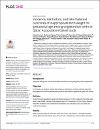Incidence, risk factors, and feto-maternal outcomes of inappropriate birth weight for gestational age among singleton live births in Qatar: A population-based study
| Author | Younes, Salma |
| Author | Samara, Muthanna |
| Author | Salama, Noor |
| Author | Al-Jurf, Rana |
| Author | Nasrallah, Gheyath |
| Author | Al-Obaidly, Sawsan |
| Author | Salama, Husam |
| Author | Olukade, Tawa |
| Author | Hammuda, Sara |
| Author | Abdoh, Ghassan |
| Author | Abdulrouf, Palli Valapila |
| Author | Farrell, Thomas |
| Author | AlQubaisi, Mai |
| Author | Al Rifai, Hilal |
| Author | Al-Dewik, Nader |
| Available date | 2021-11-07T07:18:14Z |
| Publication Date | 2021-10-01 |
| Publication Name | PLoS ONE |
| Identifier | http://dx.doi.org/10.1371/journal.pone.0258967 |
| Citation | Younes S, Samara M, Salama N, Al-jurf R, Nasrallah G, Al-Obaidly S, et al. (2021) Incidence, risk factors, and feto-maternal outcomes of inappropriate birth weight for gestational age among singleton live births in Qatar: A populationbased study. PLoS ONE 16(10): e0258967 |
| Abstract | Background Abnormal fetal growth can be associated with factors during pregnancy and at postpartum. Objective In this study, we aimed to assess the incidence, risk factors, and feto-maternal outcomes associated with small-for-gestational age (SGA) and large-for-gestational age (LGA) infants. Methods We performed a population-based retrospective study on 14,641 singleton live births registered in the PEARL-Peristat Study between April 2017 and March 2018 in Qatar. We estimated the incidence and examined the risk factors and outcomes using univariate and multivariate analysis. Results SGA and LGA incidence rates were 6.0% and 15.6%, respectively. In-hospital mortality among SGA and LGA infants was 2.5% and 0.3%, respectively, while for NICU admission or death in labor room and operation theatre was 28.9% and 14.9% respectively. Preterm babies were more likely to be born SGA (aRR, 2.31; 95% CI, 1.45–3.57) but male infants (aRR, 0.57; 95% CI, 0.4–0.81), those born to parous (aRR 0.66; 95% CI, 0.45–0.93), or overweight (aRR, 0.64; 95% CI, 0.42–0.97) mothers were less likely to be born SGA. On the other hand, males (aRR, 1.82; 95% CI, 1.49–2.19), infants born to parous mothers (aRR 2.16; 95% CI, 1.63–2.82), or to mothers with gestational diabetes mellitus (aRR 1.36; 95% CI, 1.11–1.66), or pre-gestational diabetes mellitus (aRR 2.58; 95% CI, 1.8–3.47) were significantly more likely to be LGA. SGA infants were at high risk of in-hospital mortality (aRR, 226.56; 95% CI, 3.47–318.22), neonatal intensive care unit admission or death in labor room or operation theatre (aRR, 2.14 (1.36–3.22). Conclusion Monitoring should be coordinated to alleviate the risks of inappropriate fetal growth and the associated adverse consequences. |
| Sponsor | The PEARL-Peristat study was funded by Qatar National Research Fund (Grant no NPRP 6-238-3-059) and was sponsored by the Medical Research Centre, Hamad Medical Corporation. The funders had no role in study design, data collection and analysis, decision to publish, or preparation of the manuscript. |
| Language | en |
| Publisher | Public Library of Science |
| Subject | Abnormal fetal growth pregnancy and at postpartum inappropriate fetal growth |
| Type | Article |
| Issue Number | 10 |
| Volume Number | 16 |
| ESSN | 1932-6203 |
Files in this item
This item appears in the following Collection(s)
-
Biomedical Sciences [682 items ]


